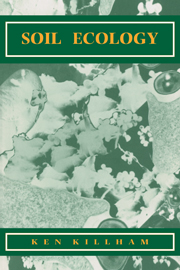Book contents
- Frontmatter
- Dedication
- Contents
- Foreword
- Introduction
- 1 The soil environment
- 2 The soil biota
- 3 Ecological interactions between the soil biota
- 4 The ecology of soil nutrient cycling
- 5 Ecology of extreme soil environments - soil water stress
- 6 Ecology of polluted soils
- 7 Manipulation of soil ecology - ‘soil biotechnology’
- References
- Further reading
- Index
5 - Ecology of extreme soil environments - soil water stress
Published online by Cambridge University Press: 12 October 2018
- Frontmatter
- Dedication
- Contents
- Foreword
- Introduction
- 1 The soil environment
- 2 The soil biota
- 3 Ecological interactions between the soil biota
- 4 The ecology of soil nutrient cycling
- 5 Ecology of extreme soil environments - soil water stress
- 6 Ecology of polluted soils
- 7 Manipulation of soil ecology - ‘soil biotechnology’
- References
- Further reading
- Index
Summary
INTRODUCTION
Adaptation of plant, microbial and animal communities (and their interactions) to prevailing conditions can readily be observed across a wide range of environmental gradients. Environmental conditions need not be extreme for adaptation to occur, although some of the most striking adaptations at both the population and organism level tend to be found in extreme, and often isolated, environments.
The forces of natural selection that determine the nature of communities under different environmental conditions were first documented by Darwin and the principles remain applicable today. Where modern techniques have been particularly of value is in identification of many of the subtle genetic changes that continually proceed and that may confer a competitive ecological advantage. The changes may be small, but with time may lead to the development of new and unique species, much better adapted to the prevailing conditions.
A variety of soil conditions can be considered extreme in terms of a habitat for the soil biota, either because of extremes in temperature, water regime, salinity, acidity or some other environmental stress. If the environmental stress is periodic, some changes to the plant, microbial and animal community may occur. Periodic water stress, for example, may prevent the establishment of an algal component to the soil microbial community. If, however, the environmental stress is maintained for a considerable period, the biota will tend to differ more strongly in terms of species composition, form and activity compared with the biota of less extreme environments. Because of the specialised nature of many of the adaptations to extreme environments, adapted organisms are often poor competitors under more moderate conditions.
One of the most interesting and widespread of extreme soil conditions occurs under water stress, matric and osmotic. Extreme soil conditions in terms of water stress do not necessarily imply an extreme soil environment in the long term. Soil water stress can occur in all soils, even in climates with plentiful and well-distributed rainfall. In fact, water availability can periodically limit plant growth in temperate, maritime climates such as the UK, although clearly, it is in the more arid regions of the earth that the effects of water stress are of most interest.
- Type
- Chapter
- Information
- Soil Ecology , pp. 151 - 166Publisher: Cambridge University PressPrint publication year: 1994



